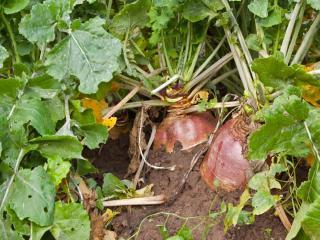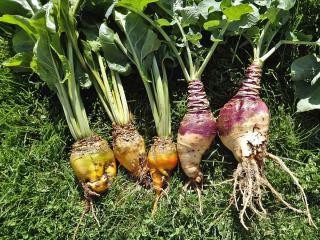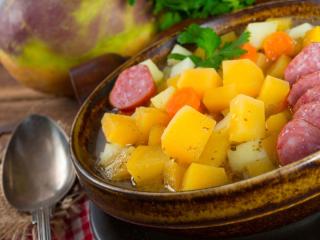

Rutabaga, also called swede when the flesh is white, is an ancient heirloom vegetable.
Key Rutabaga facts
Name – Brassica napobrassica
Family – Brassicaceae
Type – root vegetable
Height – 12 to 16 inches (30 to 40 cm)
Exposure – full sun
Soil – humus-rich, well-drained
Harvest – 3 to 4 months after sowing, from October to March.
Rutabaga is particularly well suited to climates where winters are cold and wet. From sowing to harvesting, caring and preserving, every step is important and helps produce quality rutabaga.

Cover the rutabaga seeds with ½ inch (1 to 2 cm) soil.
Once properly settled in, caring for rutabaga is quite straightforward, because this plant doesn’t require much attention.

Occasionally, when there aren’t any more appetizing host plants nearby, a female large white will come lay eggs on leaves. Simply brush the caterpillars off into a jar and feed them to chickens to get rid of them.
Rutabaga is a biennial plant, and generally only flowers in the second year. Roots are ready for harvest before that, in the first year. Leave a few of the largest behind to go to seed and prepare the following year’s seed supply.

Harvest Fall and Winter rutabaga just when you plan to eat them; they will also keep well in a cool and ventilated place.
They keep easily over several weeks, preferably in a cellar or in a cool, dark room.
You can also leave your rutabaga in the ground over the winter, even though harvesting them is a bit difficult when it freezes for a long time. To keep the soil soft, pile straw loosely atop the most mature roots, those that are next in line for the harvest. Keep the straw there for a couple weeks, the soil beneath it will warm up just enough to make harvesting a cinch. When harvesting, shift the straw over to the next few roots like a rolling carpet.
Leave them in the ground until March, at which point it’s best to harvest any remaining ones or else they’ll begin to sprout.
Rutabaga is cooked and eaten similarly to turnip, except that they generally need longer cooking.

Rutabaga are said to have therapeutic benefits, they are diuretic and help the digestive tract to “cleanse” itself. They are also fiber-rich and high in vitamin C and bring on very few calories.
It seems that rutabaga stemmed from turnips crossed with kale.
Rutabaga is a favorite of children for its nutty flavor.
This root vegetable is most often eaten cooked instead of raw, either mashed, baked with cheese, and even fried much like potatoes can be.
Pair them together with other winter vegetables such as turnips or carrots. Add them to typical winter dishes, like soup broth.
It is often easier to peel rutabaga with a sharp knife rather than the usual vegetable peeler. The thick flesh makes this difficult enough, so be forewarned!
Beware of letting the ground dry up, water abundantly during hotter months.